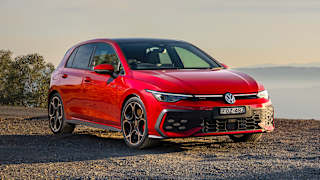As promised earlier, here’s how the Mustang GT felt powering through the French countryside…
But first, it’s worth acknowledging that, in truth, it wasn't hard work getting through the traffic even in the manual Mustang. While the clutch is on the heavier side, it’s got a smooth action and the engine's torque and flexibility make darting in and out of gaps in the traffic a breeze.
However, once out on the open roads the Mustang really could run free. The V8 engine sounded fantastic bellowing out across the fields and through the quaint little villages we passed through.
As you'd expect, the V8 provides plenty of grunt, it's an incredibly flexible engine pulling hard right across the rev range and makes us appreciate even more that this now remains the last of its kind since the demise of the V8-powered Chevrolet Camaro and Dodge Challenger.
Driving the Mustang in conditions like this makes you understand why it has been such a popular sports car not only in Australia but around the world for decades.
While the manual transmission has fallen out of favour with Aussie buyers, the truth is it's the pick for this GT. The fact it has less ratios to choose from than the 10-speed automatic means it feels more urgent and (again) the flexibility of the engine allows it to shine.
Not that the auto is bad, it does a fine job, it just lacks the buzz and engagement the manual ‘box provides.
What arguably impresses even more than the engine is the handling. Having driven the Dark Horse last year and being so impressed by its handling, particularly with the 'Performance Package', there was some concern prior to driving the GT that it would feel less impressive and, dare I say, duller.
But that's far from the case. Instead, the GT feels responsive and well sorted across a variety of road conditions. While it may lack the precise handling characteristics of a European sports car, it’s clear Ford has made this latest Mustang better suited for the rest of the world, not just America.
Not that Ford has made the Mustang too serious, as the introduction of the Drift Brake demonstrates. This rally-style electronic handbrake allows you to, as the name suggests, snap the car into a slide - when the circumstances allow.
Ford finally gave us our first (official) use of the Drift Brake when it paid us up with stunt driving expert, Paul Swift, who taught us how to slide the Mustang into a parallel park.
Obviously this is not designed for road use but for those who want to take their Mustang to the track it will no doubt lead to a lot of fun and some shredded tyres.







